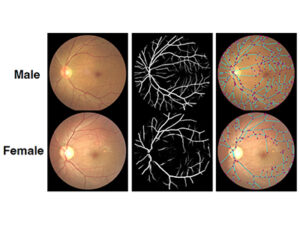The approach could lead to further biomarker discoveries to assist in disease diagnostics and early treatment interventions.
Artificial intelligence (AI) applications are revolutionizing health diagnostics and precision medicine, yet how they identify patterns of disease in layers of data has largely remained a mystery. Research led by DMCBH and Vancouver Coastal Health Research Institute researcher Dr. Ipek Oruc revealed for the first time AI behaviours that differentiated between female and male retinal images, paving the way for other novel biomarkers of disease to aid in precision care.
An expert in visual neuroscience and artificial intelligence applications of retinal image analysis, Dr. Ipek Oruc’s PNAS Nexus study charts a path for other research teams to peek under the hood of AI algorithms to understand how the algorithm was developed in order to improve patient diagnostics and outcomes using medical imaging.
“Our research opens the black box of AI, setting the stage for future research to apply this methodology to leverage its potential and identify previously unseen characteristics of various conditions.”
Oruc and her team’s proof-of-concept study examined a convolutional neural network (CNN) model trained to classify patient sex in retinal images. CNNs are a type of deep neural network AI that can mimic human cognition in image processing and classification at superhuman speeds, processing thousands of images in a matter of seconds. The technology is already applied to a number of different AI algorithms using medical imaging for the detection and classification of conditions such as cancers and heart disease.
The CNN used in Oruc’s study was trained to detect male and female retinal scans taken using a specialized fundus camera, a mainstay tool of optometry and ophthalmology used to capture images of the retina and other eye features.
Ophthalmologists and nonexperts better able to detect retinal sex difference
The research team developed and applied a novel methodology to discover for the first time retinal features that differentiate between male and female eyes. They tested 14 exploratory research questions that were derived from the behaviours and decisions of the CNN in what investigators termed the “Inspiration” phase of the model. Nine of the hypotheses revealed significant findings, five of which were verified.
These biomarkers of sex difference in retinal images included greater retinal vascularization and a darker ring around the optic disk region in male retinas as compared to female retinas.
Researchers then shared these distinguishing features with 26 expert ophthalmologists and 31 nonexperts. Prior to receiving this information, both groups’ ability to detect sex difference in retinal images averaged 50 per cent. After receiving training on the distinguishing characteristics between female and male retinal images discovered through Oruc’s novel methodology, both groups were able to identify the sex of the retinal images with approximately 66 per cent accuracy in the post-training block. This significant improvement is still a ways away from a 100 per cent detection rate, which indicates that additional differences have yet to be discovered to enable greater accuracy, Oruc says.

The two images above show subtle differences between male and female retinal images. The male image has a darker area around the optic disk, which appears as a bright spot in the images here, as well as more vasculature and nodes.
“Our findings showcase an opportunity for biomarker discovery through CNN applications, with the added benefit of equipping medical practitioners with new diagnostic options that can be added to their clinical toolkit. We are now investigating other biomarkers present in fundus images that can be identified from CNNs, such as whether changes in the eye might signal a risk of stroke or dementia.”
Oruc is also currently working on a study to apply this novel methodology to identify biomarkers in women that could lead to improvements in disease detection and treatment.
Dr. Ipek Oruc is an associate professor in the Department of Ophthalmology and Visual Sciences; member of the Djavad Mowafaghian Centre for Brain Health; associate member of the School of Biomedical Engineering; investigator with the Data Science Institute; director of the NOVA Lab at the University of British Columbia and principal investigator with ICORD.
This story was originally published on the Vancouver Coastal Health Research Institute’s website.


